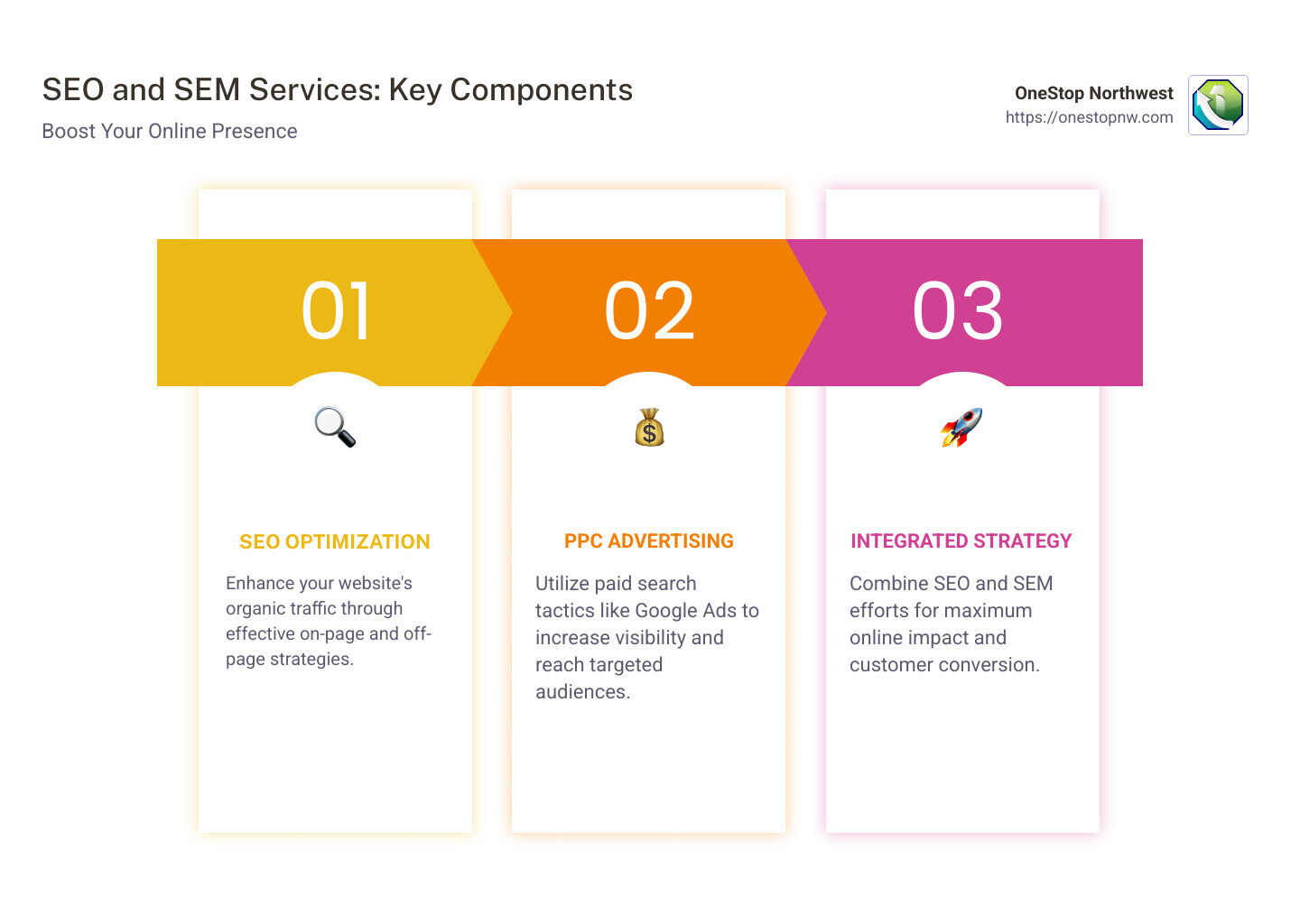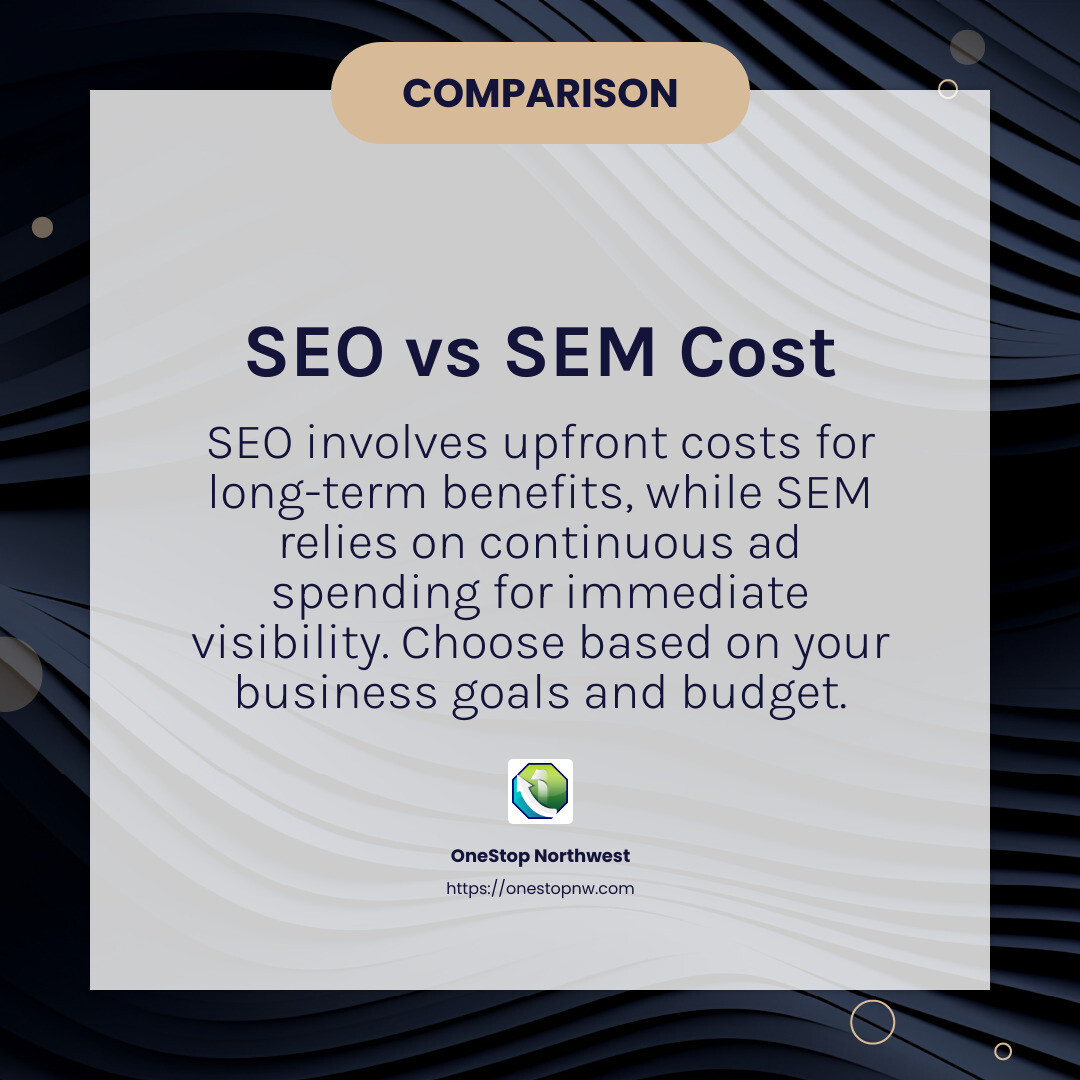SEO SEM Services: Top Strategies for 2025 Success
In today’s digital landscape, understanding the importance of seo sem services is crucial for any business looking to improve its online presence. These services effectively boost visibility and drive traffic to your website through search engine optimization (SEO) and search engine marketing (SEM). Here’s a quick breakdown:
- SEO: Increases organic traffic through on-page and off-page strategies.
- SEM: Combines SEO tactics and paid advertising like PPC to amplify visibility.
Digital marketing is not just a luxury; it’s a necessity. It plays a significant role in ensuring that your business gets noticed on crowded online platforms. With smart SEO, you can climb the search engine ranks. Meanwhile, SEM allows you to reach specific audiences with targeted ads. By integrating both, you not only attract more visitors but also convert them into loyal customers.
I’m Dylan Cleppe, and over my 20-year journey in the customer service and marketing sector, I’ve seen the transformative power of effective seo sem services. This expertise guides me in helping you steer the digital world effortlessly.
** Let’s explore how these services can propel your business into the spotlight.

What is SEO?
SEO, or Search Engine Optimization, is all about making your website more visible in search results. The goal is to get more organic, or unpaid, traffic. Think of it as a way to make your website the best it can be in the eyes of search engines like Google.
On-Page SEO
On-page SEO is like tidying up your room before guests arrive. It involves optimizing individual web pages to rank higher and attract the right audience. Here are some key aspects:
-
Keyword Optimization: Keywords are the words people type into search engines. Use them wisely in your content to match what your audience is searching for.
-
Meta Tags & Alt Tags: Meta tags are snippets of text that describe a page’s content. Alt tags do the same for images. They help search engines understand what your page is about.
-
URL Optimization: Clean and descriptive URLs make it easier for search engines to index your site.
-
Page Load Speed: Fast-loading pages improve user experience and can boost your search rankings. Tools like Google PageSpeed Insights can help you optimize speed.
-
Google Analytics & Webmaster Tools: These tools provide insights into your site’s performance and help you track your SEO efforts.
Off-Page SEO
Off-page SEO is about building your website’s reputation. It’s like word-of-mouth marketing online. Here’s what it involves:
-
Backlinks: These are links from other websites to yours. High-quality backlinks from reputable sites can boost your site’s authority.
-
Social Sharing: Encourage sharing of your content on social media platforms. This increases your reach and can drive more traffic to your site.
-
Guest Blogging & PR: Writing articles for other sites and getting mentions in the press can improve your credibility and visibility.
-
Social Bookmarking: Submitting your content to social bookmarking sites can help you reach a wider audience.
Content Creation is the backbone of both on-page and off-page SEO. High-quality, relevant content attracts visitors and encourages them to share, link, and engage with your site.
Technical SEO involves optimizing the backend of your site. This includes ensuring it’s mobile-friendly, easy to steer, and free of errors that could hinder search engines from crawling and indexing it.
SEO might seem complex, but it’s all about making your website user-friendly and valuable. By focusing on both on-page and off-page strategies, you can improve your site’s visibility and attract more organic traffic.
Next, let’s dig into SEM, where we’ll explore how to combine these organic strategies with paid advertising to maximize your online presence.
What is SEM?
Search Engine Marketing (SEM) is like putting a spotlight on your website through paid advertising. While SEO focuses on organic reach, SEM gets you fast results by paying for visibility. It’s an effective way to appear at the top of search engine results pages (SERPs) and attract more visitors.
PPC Management
Pay-Per-Click (PPC) is the backbone of SEM. With PPC, you pay a fee each time someone clicks on your ad. This model ensures that you’re only paying for actual engagement, making it a cost-effective strategy to drive targeted traffic.
Here’s how PPC management works:
-
Ad Campaigns & Ad Groups: Think of ad campaigns as the overarching theme and ad groups as specific topics within that theme. This structure helps you organize your ads and target specific customer segments.
-
Ad Text: Crafting compelling ad text is crucial. It should be engaging and relevant to the user’s search query to improve your click-through rate (CTR).
-
Budget Setting: Determine how much you’re willing to spend on your campaigns. You can set daily or monthly budgets to control your spending.
-
Metrics Monitoring: Use tools like Google Analytics and Bing Ads to track the performance of your campaigns. Keep an eye on metrics like CTR, conversion rates, and cost-per-click (CPC) to optimize your strategy.
Google Ads and Bing Ads are the major platforms for PPC. Google Ads offers extensive reach and advanced targeting options, while Bing Ads can be more cost-effective and reach a unique audience.
Remarketing
Remarketing is a technique that allows you to keep your brand in front of bounced traffic after they leave your website. It’s like giving your visitors a gentle nudge to come back and complete their journey.
Here’s how remarketing works:
-
Multiple Touches: People often need several interactions with a brand before making a purchase. Remarketing helps you achieve this by showing your ads to users who have previously visited your site.
-
Ad Retargeting: Use cookies to track visitors and display targeted ads as they browse other sites. This keeps your brand top of mind.
-
Conversion Tracking: Measure the success of your remarketing efforts by tracking conversions. This helps you understand which ads are driving valuable actions, like purchases or sign-ups.
Geo-targeting is a powerful feature in both PPC and remarketing. It allows you to target ads to users in specific locations, ensuring your message reaches the right audience.
By combining PPC management and remarketing, you can create a robust SEM strategy that boosts your online presence, drives traffic, and increases conversions. This approach ensures your brand stays visible and relevant in the competitive digital landscape.
SEO vs SEM: Key Differences
When it comes to SEO and SEM, understanding their differences is crucial for crafting an effective digital marketing strategy. Let’s break it down.
Organic vs Paid
SEO (Search Engine Optimization) is all about earning your spot on the search engine results pages (SERPs) through organic means. This involves optimizing your website’s content, structure, and authority to rank higher without paying for ad space. It’s like building a reputation through hard work and consistency.
On the other hand, SEM (Search Engine Marketing) includes paid strategies, primarily through PPC (Pay-Per-Click) advertising. This means you pay for visibility, ensuring your website appears at the top of search results quickly. It’s like renting a billboard on the internet highway.
Long-Term vs Short-Term
SEO is a long-term investment. It takes time to see significant results, often several months to a year. However, once established, it offers lasting benefits and can generate consistent traffic without ongoing costs. Think of it as planting a tree that grows and bears fruit over time.
SEM, with its PPC campaigns, provides immediate results. As soon as your ads go live, you can start driving traffic to your site. This makes SEM ideal for time-sensitive campaigns or when you need quick visibility. It’s like turning on a faucet for instant water flow.
Cost Comparison
SEO usually involves upfront costs related to content creation, tools, and possibly hiring specialists. While these costs can be significant, the long-term benefits often outweigh the initial investment. Once your site ranks well, maintaining that position requires less financial input.
SEM requires a continuous investment. You pay each time someone clicks on your ad, and the costs can vary depending on keyword competitiveness and bid amounts. For instance, high-demand keywords like “best running shoes” might cost more per click.

Visibility Speed
SEO is a slow burn. It builds a strong foundation for long-term growth, but achieving high rankings can take time. According to research, it can take up to two years to rank for competitive keywords. However, targeting long-tail keywords and following SEO best practices can yield results in a few months.
SEM offers immediate visibility. As soon as your PPC campaign is active, your ads can appear in search results. This quick turnaround is perfect for businesses needing fast exposure, such as during a new product launch or a limited-time offer.
By understanding these key differences, businesses can strategically allocate resources between SEO and SEM to maximize their online presence and achieve their marketing goals. Next, we’ll discuss the benefits of integrating both strategies into your digital marketing plan.
Benefits of SEO & SEM Services
When it comes to enhancing your online presence, SEO & SEM services offer a range of benefits that can significantly impact your business. Let’s explore how these strategies can help you.
Brand Visibility
Improving brand visibility is one of the most significant advantages of using both SEO and SEM. With SEO, your website can organically rank higher in search results, which increases your brand’s exposure. On the other hand, SEM allows you to place your ads at the top of search pages immediately. This dual approach ensures that your brand is consistently visible to potential customers, whether they’re browsing organically or clicking on paid ads.
Web Traffic
Driving more traffic to your website is crucial for business growth. SEO helps attract organic traffic by optimizing your site for search engines, while SEM targets specific audiences through paid ads. This combination can lead to a substantial increase in web traffic. For instance, a client who implemented targeted SEO strategies saw a 664% increase in organic traffic.
Lead Generation
Both SEO and SEM are powerful tools for lead generation. SEO builds credibility and trust, encouraging users to visit your site and potentially convert into leads. SEM, with its precise targeting options, can attract high-quality leads who are more likely to be interested in your offerings. By using both strategies, you can cast a wider net and capture a diverse range of potential customers.
Conversion Rates
An increase in traffic and leads is beneficial, but the ultimate goal is to convert these into paying customers. Effective SEO & SEM services focus on improving conversion rates. For example, by optimizing landing pages and using A/B testing, businesses have experienced up to an 800% increase in online leads and a 640% boost in conversion rates. This means that more visitors are taking desired actions, such as making a purchase or signing up for a newsletter.
ROI
Return on investment (ROI) is a critical measure of any marketing strategy’s success. SEO is often seen as a cost-effective method because once your site ranks well, it continues to attract traffic without ongoing expenses. SEM, although requiring continuous investment, provides immediate results and allows for precise tracking of ad performance. Clients working with expert SEM teams have reported an average 4.5X ROI, demonstrating the potential profitability of these services.
By leveraging the strengths of both SEO and SEM, businesses can improve their brand visibility, drive traffic, generate leads, improve conversion rates, and achieve a strong ROI. Next, let’s dig into the costs associated with implementing these powerful strategies.
How Much Do SEO & SEM Services Cost?
Understanding the cost of SEO & SEM services is crucial for businesses looking to optimize their online presence. Let’s break down the pricing models, average costs, and factors affecting your investment.
Pricing Models
SEO and SEM services come with various pricing structures, each catering to different business needs:
-
Hourly Rates: Ideal for specific tasks or consulting, with rates typically ranging from $100 to $300 per hour.
-
Monthly Retainers: For ongoing services, prices start around $500 per month and can increase based on the scope of work.
-
Project-Based Fees: Suitable for one-time projects like a comprehensive SEO audit, costing anywhere from $500 to several thousand dollars.
-
Performance-Based Pricing: Some agencies offer pricing tied to the results they achieve, such as increased traffic or conversions.
Average Costs
The cost of SEO & SEM services can vary widely depending on the provider and the services included. According to the research, SEM services typically range from $9,000 to $10,000 per month. For SEO, small businesses might budget at least $500 per month to see tangible results.
Factors Affecting Cost
Several factors can influence how much you pay for SEO and SEM:
-
Scope of Services: More comprehensive packages with additional services like content marketing or conversion rate optimization will cost more.
-
Agency Expertise: Experienced agencies or specialists often charge higher rates but may offer better results.
-
Industry Competition: Highly competitive industries may require more aggressive strategies, increasing costs.
-
Geographic Targeting: Local campaigns might cost less than national or international ones due to the narrower focus.
Budget Flexibility
Businesses should consider their specific needs and budget when selecting SEO and SEM services. While larger brands might invest $10,000+ per month for extensive resources, small businesses can start with a modest budget and scale as they see results. Mayple, for example, offers packages starting at $1,800 per month, providing flexible options for different business sizes.
By understanding these pricing models and factors, businesses can make informed decisions and allocate their marketing budgets effectively. Next, we’ll address frequently asked questions about SEO & SEM services to help clarify any remaining doubts.
Frequently Asked Questions about SEO & SEM Services
What is SEO and SEM services?
SEO services focus on improving your website’s visibility in organic search results. This means optimizing your site so it ranks higher on search engines like Google without paying for ads. Key components include:
- On-Page SEO: Involves optimizing meta tags, content, and URLs.
- Off-Page SEO: Focuses on building backlinks and increasing social signals.
- Technical SEO: Ensures your site is technically sound, with fast load times and proper indexing.
SEM services, on the other hand, involve paid strategies to increase visibility. This includes:
- PPC (Pay-Per-Click): Ads that appear at the top of search results, where you pay each time someone clicks.
- Remarketing: Targeting users who have already visited your site with specific ads.
- Geo-Targeting: Showing ads to users in specific locations.
SEO is about organic growth, while SEM includes both organic and paid tactics to drive traffic.
How much does SEO SEM cost?
The cost of SEO & SEM services can vary significantly based on several factors:
- SEO Costs: Generally range from $500 to several thousand dollars per month. Small businesses might start at the lower end to see results.
- SEM Costs: Typically range from $3,000 to $10,000+ per month. The cost is influenced by the scope of the campaign and the competitiveness of the industry.
Pricing Models include:
- Hourly Rates: Common for consulting, ranging from $100 to $300 per hour.
- Monthly Retainers: Ongoing services starting around $500 per month.
- Project-Based Fees: One-time projects like audits, costing $500 to several thousand dollars.
- Performance-Based Pricing: Tied to specific outcomes, like increased traffic.
Budget Considerations: It’s crucial to align your budget with your business goals. While larger companies might invest heavily, smaller businesses can start with a modest budget and scale as they see ROI.
What does an SEO SEM specialist do?
An SEO SEM specialist is responsible for implementing and managing strategies to improve search engine visibility. Their tasks include:
- SEO Strategy: Conducting keyword research, optimizing website content, and improving site architecture.
- SEM Strategy: Creating and managing paid ad campaigns, including setting budgets and monitoring performance.
- Implementation: Executing strategies across various platforms like Google Ads and Bing Ads.
- Management: Continuously analyzing data to refine strategies, improve ROI, and ensure alignment with business objectives.
These specialists use tools like Google Analytics and SEMrush to track performance and make data-driven decisions. By leveraging their expertise, businesses can improve their online presence and achieve their marketing goals effectively.
Conclusion
At OneStop Northwest, we are committed to helping your business thrive in the digital landscape. Our comprehensive SEO & SEM services are designed to boost your online presence and drive business growth.
Why Choose OneStop Northwest?
We understand that each business is unique, and that’s why we offer custom solutions to meet your specific needs. Whether you’re looking to improve your organic search rankings with SEO or want immediate visibility through SEM, we have the expertise to guide you.
Our services include:
- Custom Web Design: Ensuring your website not only looks great but also performs well in search engines.
- SEO Optimization: Enhancing your site’s content and structure for better organic rankings.
- PPC Management: Crafting targeted ad campaigns to reach your audience effectively.
- Remarketing: Re-engaging past visitors with compelling ads to boost conversions.
Benefits of Partnering with Us
-
Improved Digital Presence: By combining SEO and SEM strategies, we help you achieve a well-rounded online presence.
-
Business Growth: Our data-driven approach ensures that your marketing efforts translate into tangible business results.
-
Expert Guidance: With our team of specialists, you gain access to the latest industry insights and strategies.
-
Long-Term Success: We focus on sustainable growth, ensuring that your digital marketing strategies continue to deliver results over time.
By choosing OneStop Northwest, you’re not just investing in services; you’re partnering with a team dedicated to your success. Our SEO services are crafted to help you stay ahead in the competitive digital world.
Ready to lift your business? Let’s work together to achieve your goals and make your digital presence thrive.

